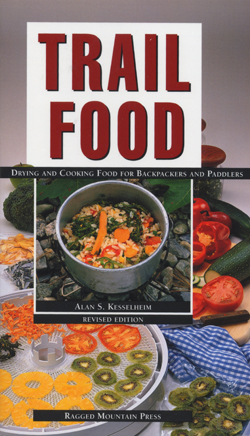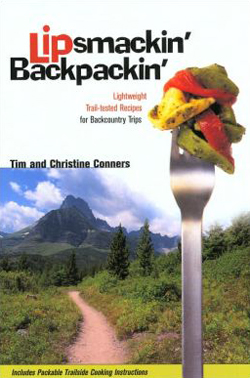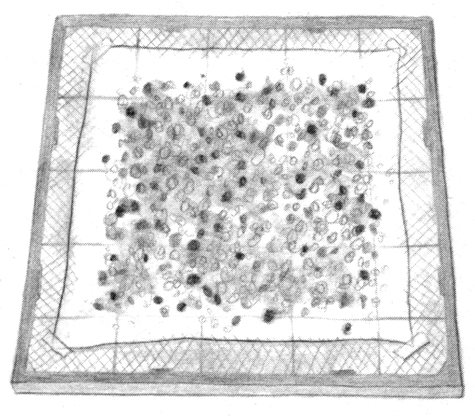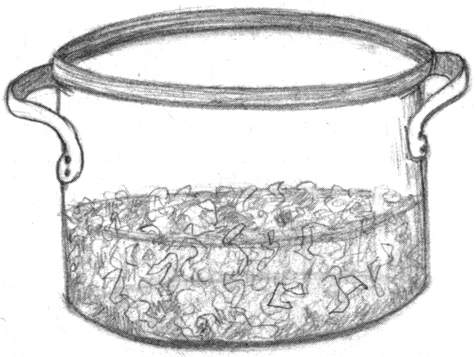Trail Food * Backpack Gourmet * Lipsmackin Backpackin

Homemade trail food cookbooks
Make your own lightweight backpacking food. To do: At home cook a dish you like, dehydrate it to reduce weight, and then rehydrate it on the trail. This is how commercial trail meals work. The difference is you make stuff you really like, tailored to your preferences (vegan, gluten-free, whatever). And it’s cheaper.
There are two camps, so to speak, about homemade dehydrated trail food. One camp dries ingredients separately to be recombined any way you want on the trail; the other makes one-pot meals and dries the entire dish at once and sealed in one bag. Then that one bag is hydrated and heated. This latter way tends to yield better results.
The thin guide Trail Food provides good instructions on how to prepare and store dehydrated trail food including drying ingredients separately, but is short on recipes. All the many recipes in Backpack Gourmet are single-dish meals, devised by a single author. The 150 recipes in Lipsmackin’ Backpackin’ are a compilation from many hikers and some of the recipes entail separate dehydrated bags, but the book has more variety of foods and snacks than the others.
09/2/13Excerpt
Sample excerpts from Trail Food:
The Price Is Right
Entire dehydrated meals often cost less than a single component of a commercially packaged entrée. I've been able to eat well and heartily for as little as three dollars a day.
Reduced Weight And Bulk
Anywhere from 50 to 90% of most food consists of water. As a result, dried meals can be reduced to a few ounces that fit in the palm of your hand. Using dehydrated food, I have canoed as long as 60 days without needing a resupply, and my boat has plenty of freeboard left. Dehydrated supplies fit easily in bicycle panniers, day packs, kayak hatches, or the cramped cupboards of a sailboat.
*
When peaches are cheap, lug home a 30-pound box instead of three or four for your fruit bowl. When green peppers are eight for a dollar, get 50! In a matter of a day or two, depending on your drying capacity, they'll be safely preserved.
Farmer's markets and fruit stands are terrific sources of fresh, unpackaged produce. Orchards often have seasonal specials or pick-your-own deals.
*
Not Worth The Effort
After years at this game, I've come to the conclusion that there are a few foods that simply aren't worth the effort to dry. Take onions, for instance. The first time we took on those little devils we brought home a 50-pound sack, chuckling all the way over our great savings. A week later we finally finished the last one off, having endured the indignities of various home cures for tearing eyes, and vowing never to dry another bloody onion as long as we lived. At one point that week, near midnight, we looked at each other over the pile of onion skins and collapsed in hysterics. Each of us wore a pair of ski goggles and a bandanna, bandit style, and had a piece of white bread stuffed in our mouth. None of it worked, so don't bother. Ever since then, we've found diced onion bits at very reasonable prices through our local health-food store.
Dried potatoes are also cheap and readily available, and save you the chopping, blanching chore. Powdered milk is expensive, but worth the price. You may find other dried products in your area stores that will be worth the laborsaving convenience.
***
Sample excerpts from Backpack Gourmet:
Drying One-Pot Meals in a Dehydrator
Time-saving Tip: Prepare extra food, enjoy some for dinner tonight, and dehydrate the rest.
Choose a one pot complete meal recipe from this book. Cook your meal at home, just as through you are preparing tonight's dinner. If you choose a meal such as spaghetti, simply prepare a spaghetti sauce--your choice of beef, seafood, or vegetarian. Then boil the pasta al dente (cooked but still firm.) Toss together the sauce and drained pasta, and put the whole dish, freshly cooked and still warm, into the dehydrator. While preparing the food, chop, grate, dice, or clive the ingredients into small pieces. These will dehydrate much faster and more successfully than large pieces of food.
Virtually all cooked foods are safe and easy to dry at home.
*
Cover mesh dehydrator trays.
*
Spread the warm, cooked meal evenly in a thin layer on the dehydrator trays and put them in the dehydrator. Overloaded trays dry slowly. All of the one-pot recipes in this book – which make four servings each – fit comfortably into a typical home dehydrator. For highest quality and food safety, speedy drying is best.
It is nearly impossible to overdry or otherwise ruin your home-dried meals using an electric dehydrator with a heat source and fan. If necessary, you can put the food in the dehydrator, leave the house, go to work for eight hours, and then turn off the dehydrator when you get home.
*
Cover pasta, quiches, or casseroles with water just above the level of food in pot.
*
The one-pot home-dried meal method requires little field equipment. Leave your frying pan, knives, forks, cutting board, plates, an extra pots at home.
***
Sample excerpt from Lipsmackin' Backpackin':
Trail Food Alan S. Kesselheim 1998, 112 pages $7 Available from Amazon Backpack Gourmet Linda Frederick Yaffe 1998, 112 pages $10 Available from Amazon Lipsmackin' Backpackin' Christine Conners, Tim Conners 2000, 248 pages $13 Available from Amazon















